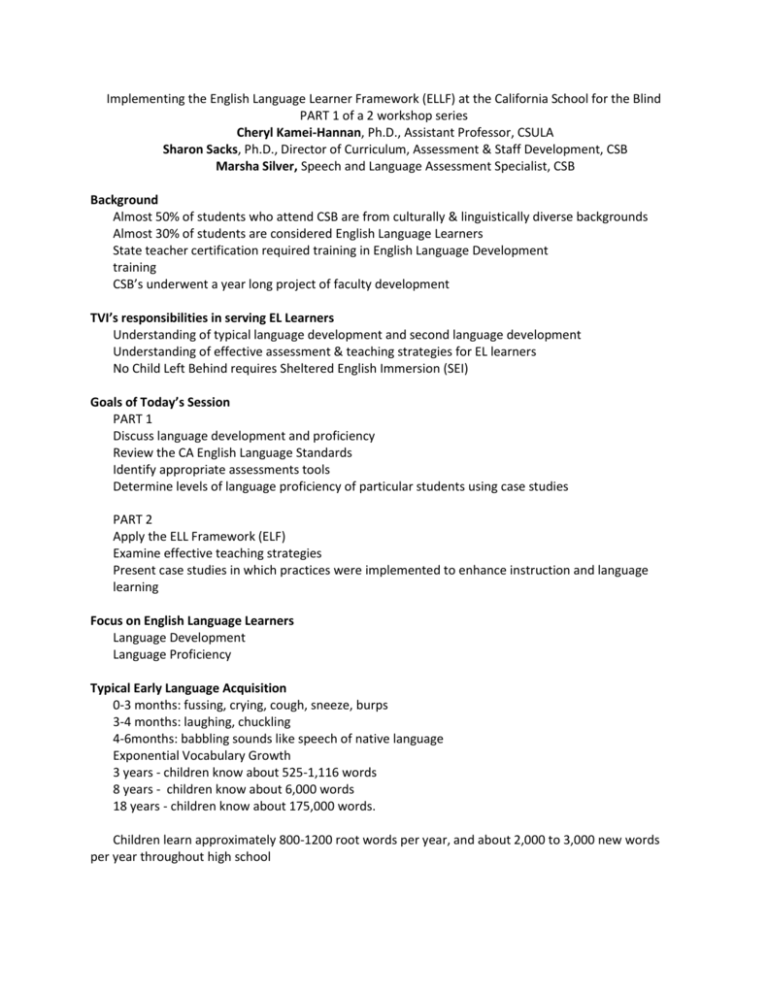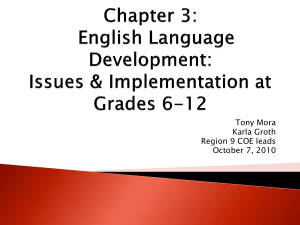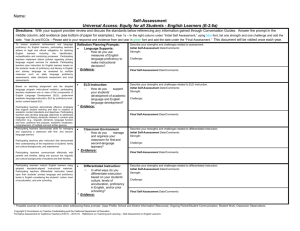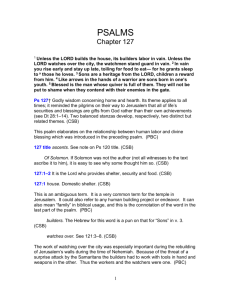Implementing the English Language Learner Framework (ELLF) at
advertisement

Implementing the English Language Learner Framework (ELLF) at the California School for the Blind PART 1 of a 2 workshop series Cheryl Kamei-Hannan, Ph.D., Assistant Professor, CSULA Sharon Sacks, Ph.D., Director of Curriculum, Assessment & Staff Development, CSB Marsha Silver, Speech and Language Assessment Specialist, CSB Background Almost 50% of students who attend CSB are from culturally & linguistically diverse backgrounds Almost 30% of students are considered English Language Learners State teacher certification required training in English Language Development training CSB’s underwent a year long project of faculty development TVI’s responsibilities in serving EL Learners Understanding of typical language development and second language development Understanding of effective assessment & teaching strategies for EL learners No Child Left Behind requires Sheltered English Immersion (SEI) Goals of Today’s Session PART 1 Discuss language development and proficiency Review the CA English Language Standards Identify appropriate assessments tools Determine levels of language proficiency of particular students using case studies PART 2 Apply the ELL Framework (ELF) Examine effective teaching strategies Present case studies in which practices were implemented to enhance instruction and language learning Focus on English Language Learners Language Development Language Proficiency Typical Early Language Acquisition 0-3 months: fussing, crying, cough, sneeze, burps 3-4 months: laughing, chuckling 4-6months: babbling sounds like speech of native language Exponential Vocabulary Growth 3 years - children know about 525-1,116 words 8 years - children know about 6,000 words 18 years - children know about 175,000 words. Children learn approximately 800-1200 root words per year, and about 2,000 to 3,000 new words per year throughout high school *Hart and Risley, (1995); Biemiller, (2006); Biemiller, (2004), as cited in Echevarria, Vogt, & Short, 2008, pg. 39; Dale & O’Rourke, (1981), as cited in Echevarria, Vogt, & Short, 2008, pg. 39; Nagy & Anderson, (1993). Stages in Second Language Development Pre-Production (silent period): Minimal comprehension; no verbal production Early production stage: Limited comprehension one-two word responses; random errors Emergent stage: increased comprehension; simple sentences; unable to correct errors; possible backsliding (plateau in language development) Intermediate fluency stage: Very good comprehension; more complex sentences; complex errors in speech; able to correct errors when they are pointed out. Stabilization stage: No problem with fluency and intended meanings; able to self-correct errors; possible fossilization (carry L1 into L2 permanently) BICS vs. CALPS BICS - Basic Interpersonal Communication Skills The conversational language that children and adults use in daily face-to-face interaction. CALPS - Cognitive Academic Language Proficiency Skills The language used in academic settings, sometimes referred to as “academic language.” The BICS/CALPS quadrants Cognitively Undemanding Context Embedded Cognitively Demanding Context Reduced Academic Language Functions To describe complex concepts as clearly as possible To describe higher-order thinking To describe abstraction Academic Language Features Figurative expressions Non-repetitive vocabulary Inexplicit terms Emphasis on factual information and evidence Use of qualifiers Unfamiliar prosody Prosody Native English speakers do not decode the spoken stream one word at a time from “left to right” in a sequential fashion. Instead, “the stressed syllable is picked out of the speech stream and is used to search the mental lexicon. Feasible candidates are selected from the mental lexicon on the basis of this syllable, and are then judged by how well they fit with the unstressed syllables that appear to their left and right” (Dalton & Seidlhoffer, 1994, pg. 39) Prosody Native English speakers do not decode the spoken stream one word at a time from “left to right” in a sequential fashion. Instead, “the stressed syllable is picked out of the speech stream and is used to search the mental lexicon. Feasible candidates are selected from the mental lexicon on the basis of this syllable, and are then judged by how well they fit with the unstressed syllables that appear to their left and right” (Dalton & Seidlhoffer, 1994, pg. 39) Prosody Native English speakers do not decode the spoken stream one word at a time from “left to right” in a sequential fashion. Instead, “the stressed syllable is picked out of the speech stream and is used to search the mental lexicon. Feasible candidates are selected from the mental lexicon on the basis of this syllable, and are then judged by how well they fit with the unstressed syllables that appear to their left and right” (Dalton & Seidlhoffer, 1994, pg. 39) Academic Language Characteristics Long sentences Passive/Impersonal voice Nominalizations Bricks and Mortar Bricks – content-specific vocabulary used in academic subjects, each discipline has it’s own set of vocabulary. Mortar – the words used in sentences to convey coherent thoughts with clarity. Principles of second language development Language development is influenced by a number of variables that interact in complex ways (e.g. first language proficiency skills, culture, socioeconomic status) Some primary language skills will transfer to second language skills (e.g. analysis, learning strategies) Academic proficiency in primary language facilitates academic language in English High-quality instruction for English Language Learners is similar to high-quality instruction for all learners, but second language learners may need additional supports and instructional accommodations English language learners need enhanced, explicit vocabulary development *Echevarria, J., Vogt, M. , Short, D.J., (2008). Making Content Comprehensible: The SIOP Model. Pg. 12 CA Standards for English Language Development - Organization of the CA ELD Standards Summary Areas: Listening & Speaking Reading Writing Summary Levels: Beginning Intermediate Advanced 3 areas are divided into Substrands Strategies & Application are given by grade level ELD Levels are further broken down into: Beginning Early Intermediate Intermediate Early Advanced Advanced Assessment CA ELD Student Observation Matrix Design: The Matrix is modeled after the SOLOM (CDE, 1981). It incorporates CA ELD Standards from grades 1-5 and arranges them into the 3 areas Listening & Speaking, Reading, and Writing. Purpose: The purpose of the matrix is to assist teachers in determining ELD strategies and applications by using observations. Case Study #1 - Josselin Josselin was diagnosed with bilateral retinoblastoma at 18 mos. Her left eye was removed at 2 years of age; right eye at 4 years of age She was born in El Salvador and moved to Guatemala to live with her grandmother while her parents came to the U.S. Josselin attended a school for the blind for 7 months, but her schooling was discontinued due to transportation problems. Josselin joined her parents in E.P.A. at 8 years of age and was enrolled in CSB at 8 years 9 months. She is a bright, joyful young girl with fluent Spanish language skills. Case Study #1 - Josselin According to the CA ELD Observation Matrix 9/2010 Listening and speaking - beginning level Reading and Writing - below beginning level 9/2011 Listening and speaking - between early intermediate and intermediate Reading and Writing - early intermediate Case Study #2 - Andres Andres – 19 years old; learning functional skills; Spanish home language, but doesn’t read in Spanish; in listening and speaking 2-3 range. ELL Framework Examples of Language Goals Developing Key Vocabulary Student will be able to define terms and use them in oral discussions. Improving Language Function Student will be able to formulate questions. Student will make predictions about a story. Improving Oral Listening Skills Student will identify the main idea, characters, or setting of a story. Examples of Language Goals Focusing on Grammar or Language Structure Student will recognize the difference between declarative sentences (telling sentences) and interrogatory sentences (questions). Given a sentence, student will be able to recognize adjectives that describe nouns. Developing Language Needed for Tasks Student will listen to the directions and identify needed materials to complete the task. Applying the ELL Framework Consider: Student’s culture, prior home experiences, language ability, interest and motivation Functional vision, accessibility needs, visual supports accommodations Past instruction, academic history, content knowledge, cognitive ability Recap - Goals of Today’s Session PART 1 Discuss language development and proficiency Review the CA English Language Standards Identify appropriate assessments tools Determine levels of language proficiency of particular students using case studies PART 2 Apply the ELL Framework (ELF) Examine effective teaching strategies Present case studies in which practices were implemented to enhance instruction and language learning








